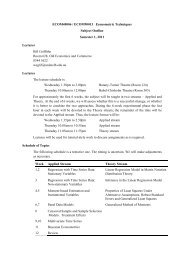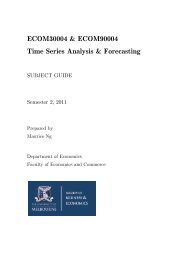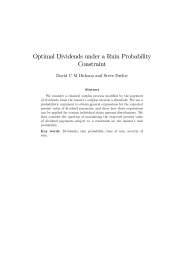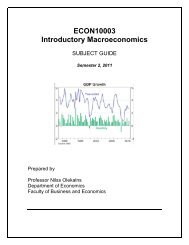Yet another difference <strong>of</strong> our model from ? is that inefficient investment in our model doesnot arise because <strong>of</strong> a debt overhang problem. In fact, we do not view our model as much amodel <strong>of</strong> banks, as we view it <strong>of</strong> a model <strong>of</strong> government bailouts for generic non-bank firms,such as the GM <strong>and</strong> Chrysler. But like ?, we focus on the socially inefficient aspects <strong>of</strong> firmbehavior. <strong>Bailouts</strong> are needed because it is too costly for the firm to finance continuation, giventheir struggle with their own internal moral-hazard (managerial agency) problems. Our paperfocused on on the internal <strong>and</strong> external moral-hazard problems <strong>and</strong> their best remedies. Ourdistortive tax effects are endogenous, <strong>and</strong> not linear as in ?. We also <strong>of</strong>fered specific policyrecommendations (on managerial <strong>and</strong> owner retention, bailout funding, etc.) different fromthose in ?, <strong>and</strong> showed that firms <strong>and</strong> managers—the Chamber <strong>of</strong> Commerce—will lobby for asystem in which they do not face a priori taxation to cover future bailouts.? <strong>and</strong> ? study adverse-selection models, in which firms differ in the publicly-unknownqualities <strong>of</strong> their existing assets. In contrast, our model studies moral-hazard problems in firmswith known assets <strong>and</strong> opportunities. In their models, the government ends up subsidizing onlythe worst types, whereas in our model, the government ends up subsidizing only the marginaltypes. In their models, the parameterized cost <strong>of</strong> public funds is exogenous, whereas in ourmodel, the costs <strong>of</strong> raising bailout revenue (through taxes) is endogenous. This is important,because distortionary taxes (<strong>and</strong> T 2 , in particular) reduce managerial effort <strong>and</strong> are thus directlyresponsible for our policy prescriptions. In ?, the acceptance <strong>of</strong> government assistance sends anegative signal to outside capital market participants, which increases the recipients’ privateborrowing costs outside <strong>of</strong> the program. ? government objective is to obtain a target level<strong>of</strong> investment that is the cheapest to taxpayers. In our model, the government maximizestotal social value instead. Their optimal government intervention is a debt contract. Our’s isa direct subsidy (because any government stake raises the required subsidy to entice privateparticipants). In ?, there is a spillover aspect <strong>of</strong> bailouts. The bailout <strong>of</strong> one firm raises the cost<strong>of</strong> the next bailout. Firms become progressively more hesitant to participate as progressivelyweaker banks have already been bailed out before them. Like ?, the government takes stakes inexchange for its subsidy, though in equity <strong>and</strong> direct purchases <strong>of</strong> firm assets, whereas in ourmodel, the government should take no such stake. 24There are also pre-2008 crisis papers in the banking literature in which bailouts can bevaluable. For example, in ?, banks would lose socially valuable information if allowed todisappear. In ?, asset prices depend on liquidity, <strong>and</strong> the government can enhance assetvalues by tapping its effectively unlimited credit. In ?, managers can be reluctant to liquidateunderperforming loans when bank regulators close bankrupt banks aggressively. <strong>Bailouts</strong> aredesigned to minimize such welfare losses. The classic paper advocating some governmentinvolvement is ?, which showed how the private market can fail <strong>and</strong> how deposit insuranceor convertibility restrictions can enhance the social outcome. As expected, deposit insurance24 Like us, Tirole suggests “just enough” intervention. Although moral hazard is not central to his analysis, hedemonstrates (as do we) that bailouts can exacerbate moral-hazard concerns. The paper does not derive anoptimal bailout in the presence <strong>of</strong> moral hazard.28
immediately raises moral-hazard concerns, e.g., as in ?, ?, ?, ?, etc. Ex-ante regulation <strong>of</strong> thebanking sector is usually recommended as a corollary to ex-post deposit insurance.Similarly, in a long number <strong>of</strong> papers on the subject <strong>of</strong> government procurement <strong>and</strong>intervention, Tirole emphasizes how firms can game the system. For example, in ?, firmscorrelate on exposures in order to benefit more from government bailouts:...the central argument <strong>of</strong> the paper is that private leverage choices depend on theanticipated policy reaction...An accommodating interest rate policy involves (a) aninvisible subsidy from consumers to banks (the lower yield on savings transfersresources from consumers to borrowing institutions), (b) current costs, such asthe (subsidized) financing <strong>of</strong> unworthy projects by unconstrained entities, <strong>and</strong> (c)deferred costs (the sowing <strong>of</strong> seeds for the next crisis, both through incentives formaturity mismatch, going forward, <strong>and</strong> the authorities’ loss <strong>of</strong> credibility)...Wheneveryone engages in maturity mismatch, authorities have little choice but intervening,creating both current <strong>and</strong> deferred (sowing the seeds <strong>of</strong> the next crisis) socialcosts.Finally, ? is unusual in that governmental bailouts can backfire even ex-post <strong>and</strong> themselvescause further insolvencies. Of course, although our paper has not allowed for an additionaldirect waste parameter in the process <strong>of</strong> government intervention, we do not suggest that oneshould ignore the governmental rent-seeking issues first raised in ? <strong>and</strong> ?. Although thesepapers raise significant real-world problems, our own view <strong>of</strong> government intervention, thoughskeptic, is decidedly less pessimistic. Our model’s assumption <strong>of</strong> an optimizing government wasa useful analysis device, not a description <strong>of</strong> real life. To the extent that rent-seeking makesgovernment intervention more costly, it shrinks the regions in which governmental interventionis beneficial. However, the main insight—that when social externalities are large, bailouts canbe optimal, <strong>and</strong> they tend to be better if the managers are dismissed—is robust.As far as know, no other model <strong>of</strong> bailouts has focused on the positive a priori incentiveeffects <strong>of</strong> tieing bailouts with managerial dismissals.6 ConclusionIn its final report to Congress in March 2011, the TARP Congressional Oversight Panel (COP)<strong>of</strong>fered the following assessment <strong>of</strong> the automotive industry bailout:Treasury’s interventions in the automotive industry, in particular, raise moral hazardconcerns. In some ways, Treasury actually mitigated moral hazard through its verystrict approach to these companies: it forced GM <strong>and</strong> Chrysler to enter bankruptcy, astep not required <strong>of</strong> other major TARP-recipient institutions. However, the mere factthat Treasury intervened in the automotive industry, rescuing companies that werenot banks <strong>and</strong> were not particularly interconnected within the financial system,29
















